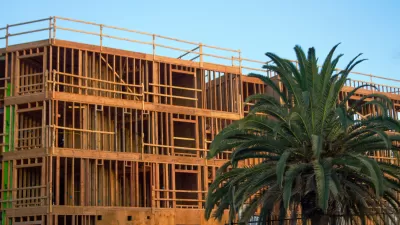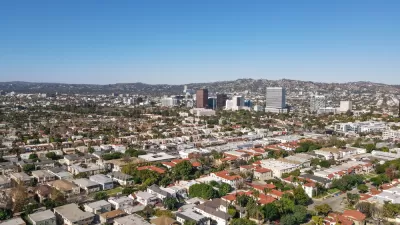The Newsom administration sent a letter warning Beverly Hills that their failure to process an application for a residential high-rise is a violation of state housing law

According to an LAist article, “California housing officials are sending a message to the city of Beverly Hills: approve plans for a high-rise apartment building, or we’ll see you in court.” Last week the California Department of Housing and Community Development sent a letter to Beverly Hills city council warning that their failure to process an application for a 165-unit apartment building along densely developed Wilshire Boulevard. In a statement, Gov. Newsom said, “[Beverly Hills’s] attempt to block this housing project violates the law. Now is a time to build more housing, not cave to the demands of NIMBYs.”
Beverly Hills officials say they have not yet denied the project and their actions so far have been “procedural in nature,” reports David Wagner for LAist. The city’s most recent action in June was to deny an appeal from the developer challenging the city’s conclusion that the project application was “incomplete.” Plans for the building were submitted in October 2022 under a provision known as “Builder’s Remedy,” which allows developers to propose eligible housing development projects that do not comply with either the zoning or the general plan in cities without a state-approved housing plans. As of January of this year, Beverly Hills was two years late in developing a housing plan compliant with state laws requiring the city to plan for 3,104 new units by 2029, more than half of which must be affordable to low-income households.
The HDC has given the city until September 20, 2024 to respond to its letter. If approved, the high-rise in question would be one of the city’s tallest residential buildings, with 20 percent of the apartments reserved for low-income renters and also contain a hotel.
FULL STORY: Newsom administration tells Beverly Hills its efforts to block a high-rise violate state housing law

Planetizen Federal Action Tracker
A weekly monitor of how Trump’s orders and actions are impacting planners and planning in America.

Maui's Vacation Rental Debate Turns Ugly
Verbal attacks, misinformation campaigns and fistfights plague a high-stakes debate to convert thousands of vacation rentals into long-term housing.

San Francisco Suspends Traffic Calming Amidst Record Deaths
Citing “a challenging fiscal landscape,” the city will cease the program on the heels of 42 traffic deaths, including 24 pedestrians.

Amtrak Rolls Out New Orleans to Alabama “Mardi Gras” Train
The new service will operate morning and evening departures between Mobile and New Orleans.

The Subversive Car-Free Guide to Trump's Great American Road Trip
Car-free ways to access Chicagoland’s best tourist attractions.

San Antonio and Austin are Fusing Into one Massive Megaregion
The region spanning the two central Texas cities is growing fast, posing challenges for local infrastructure and water supplies.
Urban Design for Planners 1: Software Tools
This six-course series explores essential urban design concepts using open source software and equips planners with the tools they need to participate fully in the urban design process.
Planning for Universal Design
Learn the tools for implementing Universal Design in planning regulations.
Heyer Gruel & Associates PA
JM Goldson LLC
Custer County Colorado
City of Camden Redevelopment Agency
City of Astoria
Transportation Research & Education Center (TREC) at Portland State University
Jefferson Parish Government
Camden Redevelopment Agency
City of Claremont





























